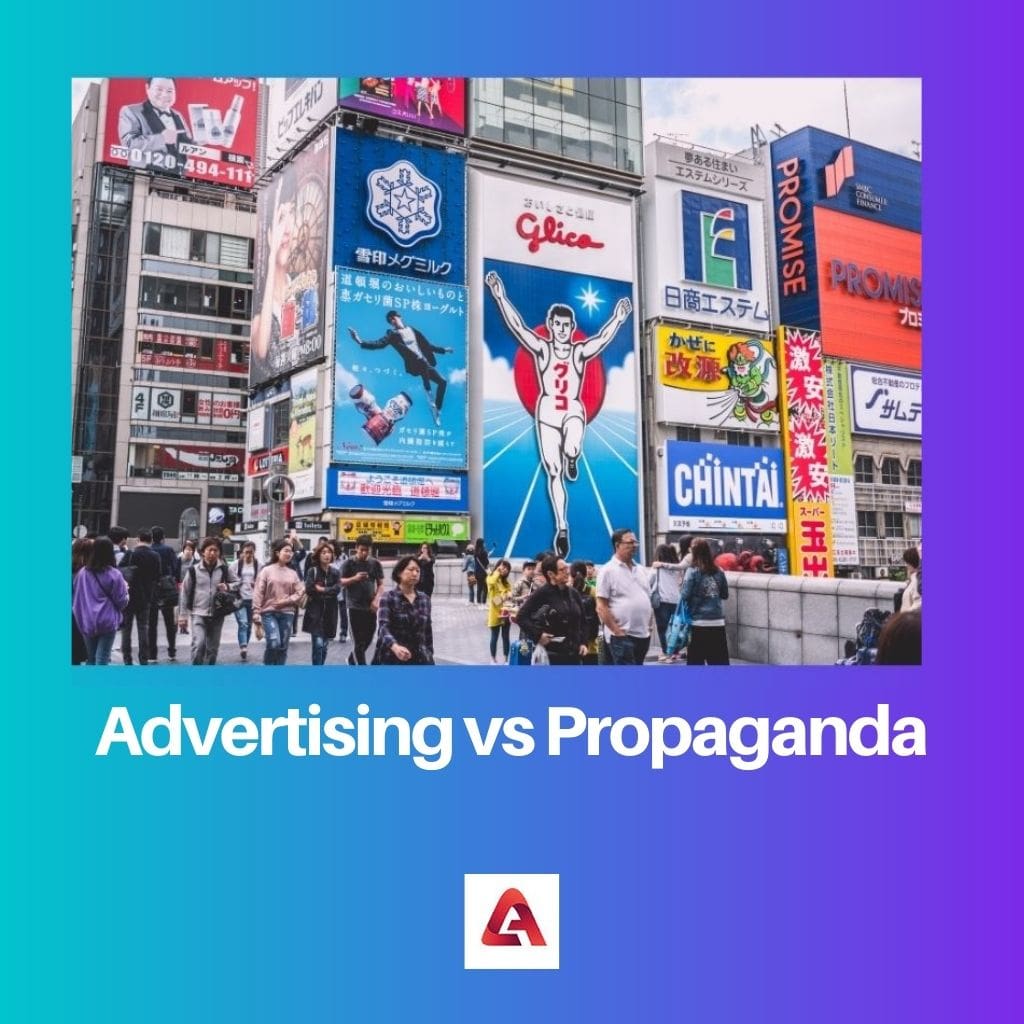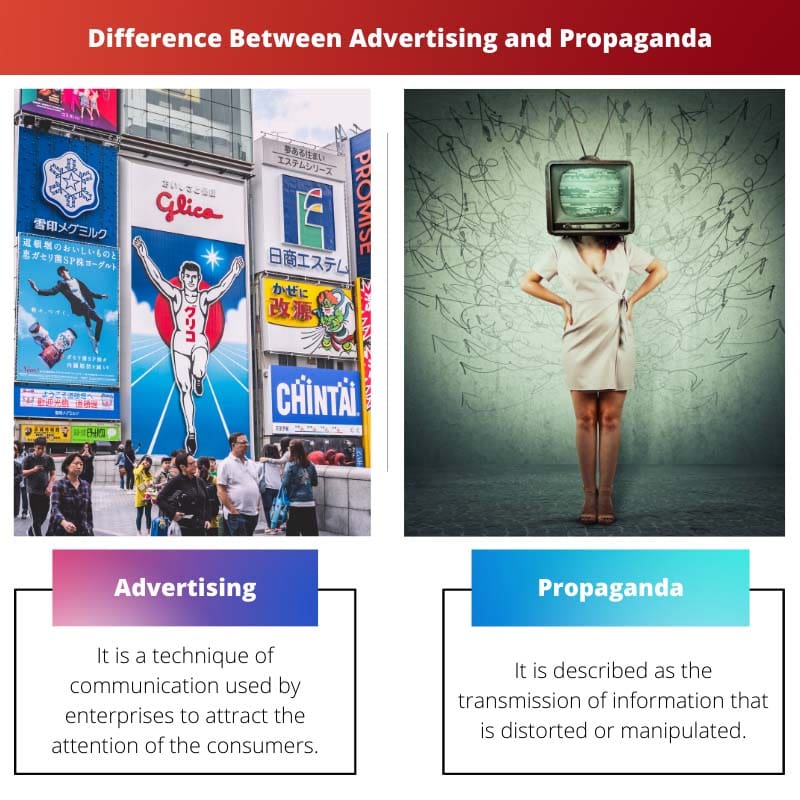Advertising and Propaganda are two distinct and powerful tools used by the media to influence the mind of the general public. They are interrelated insofar as both emerged in the late nineteenth and early twentieth century due to the rise of large-scale production and some notable political events, especially the World Wars.
Both of them extensively use media (print and electronic), technology, and a variety of symbols to attract public attention.
Keskeiset ostokset
- Advertising is a form of communication used by businesses to promote their products or services to consumers, to persuade them to purchase or engage with the brand; propaganda is a form of communication aimed at influencing the attitudes, opinions, or beliefs of a target audience, for political or ideological purposes.
- Advertising focuses on promoting a specific product, service, or brand, while propaganda seeks to shape public opinion and perceptions, by using biased or misleading information.
- Both advertising and propaganda use persuasive techniques to influence their target audiences. Still, advertising is primarily concerned with driving sales and brand awareness, whereas propaganda is more focused on shaping public opinion and promoting a specific ideology or agenda.
Mainonta vs propaganda
Advertising is a form of marketing communication that aims to promote a product or service by providing information about its features, benefits, and value proposition. Propaganda is a form of persuasive communication that aims to manipulate people’s beliefs, attitudes, and behaviors.

Mainonnalla tarkoitetaan tekniikoita ja käytäntöjä, joita käytetään tuomaan tuotteita, palveluita tai syitä yleisön huomion taivuttelemiseksi ajattelemaan ja reagoimaan tietyllä tavalla.
Propaganda, conversely, is defined as a systematic attempt to influence the minds and emotions of a target group to achieve a specific purpose. It is done by disseminating information that is biased and manipulated.
Conversely, the latter involves the distortion of information and manipulation of symbols to support a particular standpoint. The communication in Propaganda is one-directional, and there is no need to prove whether the information disseminated is accurate.
Vertailu Taulukko
| Vertailuparametri | mainonta | Propaganda |
|---|---|---|
| Määritelmä | It is a communication technique used by enterprises to attract consumers’ attention toward their products or services. | It is described as transmitting information distorted or manipulated to support a particular view or initiative. |
| Tarkoitus | To mold the consumers’ preferences to support a particular product or service. | To mold the people’s minds to support a particular idea or program. |
| Hakemus | It is mainly used in the market to promote certain goods, services, or causes. | It is used in all spheres of life-social, political, and economical. But it is most prominently used in the political arena. |
| Tietoa levitetty | Tosiasioihin perustuva | Manipuloitu ja vääristynyt |
| Seuraus | Se johtaa yritysten myynnin ja voittojen kasvuun. | Se johtaa tietyn idean tai aloitteen voittoon toisesta. |
Mikä on mainonta?
It is a communication method used to promote specific products, services, or causes to persuade people to respond to them in a particular way. It is one of the four marketing keys, and the nature of communication is persuasive and non-personal.
Mainoksia käytettiin ensimmäisen kerran Lontoon viikkolehdissä XNUMX-luvulla. XNUMX-luvulla tällaiset mainokset kukoistavat. Ensimmäiset mainostoimistot perustettiin kuitenkin vasta XNUMX-luvulla.
They acted as a broker for making space in newspapers.
By the early twentieth century, they produced advertising messages, including copies and artworks.
Advertisements are mainly backed by enterprises aspiring to publicize their commodities or services. However, they can also disseminate public service messages to promote causes, charities, or political candidates.
Although fact-based, advertisements are designed to create an impression in people’s minds and influence them to subscribe to the products or services being promoted. For example, various symbols and striking graphic displays are used in advertisements to gain the attention of the people.
Some of the primary mediums through which Advertising permeates the lives of people include:
- Painettu media: Sisältää sanoma- ja aikakauslehdet.
- Tiedotusväline: Sisältää radion ja television.
- Toissijainen media: Supports print and broadcast media, e.g., posters and billboards.
- Sosiaalinen media: With the growing popularity of the internet, social media is seen as an effective medium for advertising. For example, Google, Facebook, etc.
- Tuotesijoittelu refers to gaining exposure to products by featuring them in TV programs and films.
- Suoramarkkinointi: It involves promoting products or services by establishing individual contact with potential consumers, e.g., emails, messages, texts, etc.
Mainonta eroaa henkilökohtaisesta myynnistä viestintätyypissä olevien erojen vuoksi. Toisin kuin henkilökohtaisessa myynnissä, mainonnassa välitettävä viesti ei ole henkilökohtainen.
That is to say; it is not targeted at a specific individual.
Se eroaa PR:stä myös siinä mielessä, että mainoksissa levitettävän viestin sisältöä valvovat tiukasti sen sponsorit.
In many countries, advertising is a significant source of income for the media through which it is done.

Mitä on propaganda?
It is defined as the dissemination of information that is manipulated or distorted to gain the support of the people for a cause (political) or a point of view.
The origin of the term can be traced back to the seventeenth century. It was first given currency by a missionary organization established by the Pope in 1622named Congregatio de Propaganda Fide, i.e., Congregation for the Propaganda of the Faith –to refer to the transmission of its doctrines.
The term is used negatively mainly because of its extensive use by Nazi Germany and the former Soviet Union to gather support for their ideas and programs during the inter-war period of 1919 to 1939.
While disseminating information, Propagandists emphasize those elements of the information that support their cause or view and de-emphasize those that do not back their views or cause. To garner support for their views, propagandists also transmit lies and misleading statements.
Tämä Propagandan välittämän tiedon manipuloiva luonne erottaa sen mainonnasta.
Propaganda is used in all spheres of life- social, economic, and political. But it is most profound in the political arena.
Some of the significant elements of Propaganda are as follows:
- Esitysmenetelmät: The art of presentation constitutes the heart of Propaganda, as it is through the presentation that a lie or a half-truth can be transformed into truth and vice-versa.
- Tekniikat huomion saamiseksi: After presenting a particular view, the next step is to gain the target audience’s attention. Various methods are used, such as radio, television, motion pictures, print media, conferences, the internet, etc.
- Laitteet vastauksen saamiseksi: One of the significant aims of Propaganda is to evoke a favorable response from the target audience. For that, a variety of symbols, images, and sentimental and emotional appeals are used by the Propagandist.
- Menetelmät hyväksynnän saamiseksi: Lopullinen tavoite of Propaganda is to gain acceptance among people so that the view, idea, cause, or product becomes a part of the common sense of the people.

Mainonnan ja propagandan tärkeimmät erot
- Both terms are somehow concerned with molding the views and choices of the people in a specific direction and therefore are confused with each other. But in reality, they are entirely different from each other. The primary difference between Advertising and Propaganda is that the former is primarily related to the market arena, while the latter is most prominently used in the political arena.
- The main intention of Advertising is to muotti the preferences of the consumers and to persuade them to purchase a particular product or service. Conversely, propaganda intends to mold people’s minds and influence them to subscribe to a particular idea or initiative.
- The information transmitted through advertisements is biased towards a particular product or service, but they are based on facts and bring forward all the aspects of that product. Conversely, Propaganda is all about distortion and manipulation of information to gather people’s support for a particular view or program.
- Although both Advertising and Propaganda became popular in the early twentieth century, the former resulted from the emergence of mass- production. At the same time, the latter emerged due to some important political events, especially the World Wars.
- A good Advertisement enables an enterprise to earn more profits through increased sales. While successful Propaganda results in the victory of a particular idea or program over other contending ideas or programs.

- https://muse.jhu.edu/article/484935/summary
- https://search.informit.com.au/documentSummary;dn=818812381907979;res=IELHSS
- https://uhpress.hawaii.edu/product/the-thought-war-japanese-imperial-propaganda/
Viimeksi päivitetty: 16. huhtikuuta 2024

Chara Yadav on koulutukseltaan rahoituksen MBA. Hänen tavoitteenaan on yksinkertaistaa talouteen liittyviä aiheita. Hän on työskennellyt rahoitusalalla noin 25 vuotta. Hän on pitänyt useita rahoitus- ja pankkikursseja kauppakorkeakouluissa ja yhteisöissä. Lue häneltä lisää bio-sivu.

